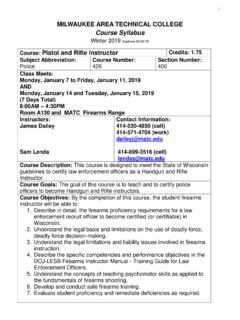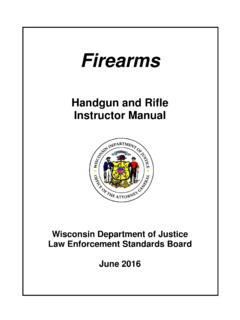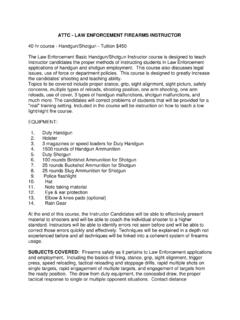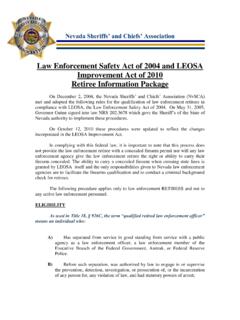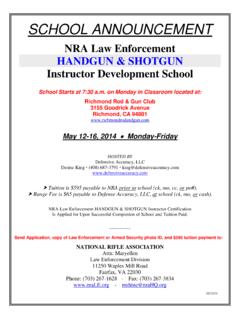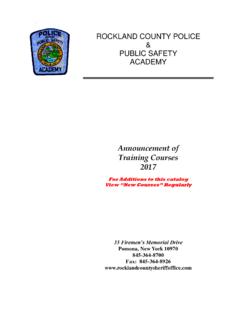Transcription of Firearms - Welcome to MATC
1 Firearms instructor Manual Wisconsin Department of Justice Law enforcement Standards Board September 2012 September 2012 2 The Law enforcement Standards Board approved this textbook on September 5th, 2012. Training Academy effective date is May 1, 2013. All law enforcement basic preparatory training courses that begin on or after May 1st, 2013 must incorporate this updated textbook and any related updates to the curriculum. Courses beginning before that date may elect to use these updated materials. September 2012 3 ACKNOWLEDGEMENTS The Training and Standards Bureau, Wisconsin Department of Justice gratefully acknowledges the dedication of the Firearms Training Advisory Committee, which has developed the lesson plans, videos, and exercises for use by certified Firearms instructors. The current members (and active emeritus members) of the Committee are Designated Representatives Mike Valencia, Sheriff s Representative Russell Jack, Chief s Representative Andrew Kleppe, Wisconsin Technical College System Robert Defrang, Wisconsin State Patrol Joseph Seitz and James MacGillis, Milwaukee Police Department Dennis Konkel, Milwaukee County Sherriff s Office Kimba Tieu, Madison Police Department Stephanie Pederson and Glenn Rehberg, Training and Standards Bureau Practitioners Dennis Angle, Waukesha Police Department Mark Bauman, Chippewa Falls Police Department Steve Harlow, Glendale Police Department Mike Jaszczak, Superior Police Department Mark Kohl, Fox Valley Technical College Brian Landers, Madison Area Technical College Raymond Merlin, Kenosha County Sheriff s Office Emeritus (non-voting)
2 Members Randy Revling Dan Marcou Bob Willis Gary Klugiewicz Special thanks to Chad Abram and Stacy Polodna of the Prairie du Chien Police Department and Minh Duc "Kimba" Tieu of the Madison Police Department for agreeing to be photographed demonstrating Firearms techniques. September 2012 4 TABLE OF CONTENTS ACKNOWLEDGEMENTS .. 3 TABLE OF CONTENTS .. 4 COMPETENCIES AND PERFORMANCE OBJECTIVES .. 6 instructor OVERVIEW .. 8 INTRODUCTION .. 8 TEACHING TOOLS .. 16 TRAINING TIPS .. 17 instructor REQUIREMENTS .. 21 TOPIC 1: INTRODUCTION AND LEGAL CONTEXT .. 22 LESSON 1-1: DEADLY FORCE DECISIONS .. 22 INSTRCTOR NOTES: SAFETY, USE AND CARE OF Firearms .. 30 LESSON 1-2: BALLISTICS AND SAFETY .. 32 LESSON 1-3: PISTOL FUNCTION .. 38 LESSON 1-4: PISTOL MAINTENANCE .. 44 instructor NOTES: TEACHING SHOOTING FUNDAMENTALS .. 50 instructor NOTES: SAFETY PROCEDURES FOR CLASSROOM AND LIVE-FIRE ENVIRONMENTS.
3 51 instructor NOTES: PLANNING AND MANAGING A FIRING RANGE .. 58 TOPIC 2: SHOOTING BASICS .. 64 LESSON 2-1: FIVE FUNDAMENTALS .. 64 LESSON 2-2: THE DRAW STROKE AND READY POSITIONS .. 76 LESSON 2-3: LOADING AND UNLOADING .. 84 LESSON 2-4: CLEARING MALFUNCTIONS .. 92 TOPIC 3: COVER, MOVEMENT AND POSITION .. 98 LESSON 3-1: USING COVER .. 98 LESSON 3-2: SHOOTING POSITIONS .. 108 LESSON 3-3: SHOOTING WHILE MOVING .. 114 TOPIC 4: SPECIAL CIRCUMSTANCES .. 122 LESSON 4-1: MULTIPLE ADVERSARIES AND CLOSE COMBAT .. 122 LESSON 4-2: SHOOTING UNSUPPORTED AND WHILE SEATED .. 127 LESSON 4-3: SHOOTING IN LOW LIGHT OR DARKNESS .. 140 LESSON 4-4: ACTIONS AFTER COMBAT SHOOTING .. 150 TOPIC 5: LONG GUNS .. 156 LESSON 5-1: LONG GUN CHARACTERISTICS .. 156 LESSON 5-2: MALFUNCTIONS AND LIVE FIRE FAMILIARIZATION .. 164 September 2012 5 TESTING GUIDELINES .. 172 178 APPENDIX A: BASIC CASE LAW.
4 179 TERRY V. OHIO, 392 1 (1968) .. 180 GRAHAM V. CONNOR 490 386 (1989) .. 183 Competencies and Performance Objectives September 2012 6 COMPETENCIES AND PERFORMANCE OBJECTIVES 1. Identify the issues that are associated with deadly force decision-making and the use of deadly force. Identify and describe the legal and policy issues involving the use of deadly force. Define deadly force and explain justified use of deadly force within the defensive and arrest tactics Intervention Options. Define imminent threat and the criteria that need to be met in order for a threat to be imminent. Assess whether alternatives to shooting are appropriate when encountering a potentially life threatening situation. Identify the target requirements that must be met in order to use deadly force. 2. Exhibit good weapon-handling skills. Comply with general Firearms safety rules.
5 Comply with general range safety rules. Store Firearms in a safe manner when not on duty. Secure a firearm other than one s own. 3. Properly maintain the duty weapon and its associated equipment. Identify and describe the role that ballistics play in the performance of the duty weapon. Identify various types of Firearms and the major functional parts of these Firearms . Identify nomenclature and functions of ammunition. Identify the various types of semi-automatic pistols and their design and functional differences. Field-strip the duty weapon. Clean and lubricate the duty weapon. Perform a function check of the duty weapon. Maintain duty belt, holster and magazine pouches. 4. Is able to fire the duty weapon accurately in a variety of conditions and environments. Demonstrate proficiency in basic marksmanship in a variety of tactical situations.
6 Employ the correct technique for drawing the weapon and for recovering the weapon to the holster. Competencies and Performance Objectives September 2012 7 Identify and describe the ready positions that an officer may employ with a drawn weapon and the uses for these positions. Load, reload, and unload the weapon. Identify various types of weapon malfunctions and the causes of these malfunctions. Demonstrate clearing malfunctions. Identify cover and how to use cover. Identify and describe the various shooting positions and the advantages and disadvantages of each position. Demonstrate shooting using various shooting positions. Identify the issues involved when multiple adversaries are to be engaged. Identify the issues involved when close combat shooting occurs. Identify the issues involved when using unsupported shooting techniques.
7 Identify the issues involved when shooting in low light levels. 5. Take appropriate actions after combat shooting. Assess threat to determine if it has been neutralized. Complete post-shooting legal procedures. Prepare to testify in court related to a shooting incident. 6. Demonstrate familiarity with the operation of long guns. Identify the various types of shotguns and their design and functional differences. Identify the various types of rifles and their design and functional differences. Identify the various parts of long guns. Identify the purposes and types of long gun ammunition. Demonstrate the safe handling of long guns. Load, reload, and unload a long gun. Demonstrate shooting a long gun. Identify various types of weapon malfunctions and the causes of these malfunctions. Demonstrate clearing a malfunction. Summative Assessment: Fire the duty weapon accurately and take appropriate actions after combat shooting in a variety of conditions and environments (Mandatory Summative Assessment for all recruits) * ** Complete the Basic Firearms Course final written test.
8 ** Fire weapon in static environments through practical applications in a simulated environment. ** Initiate proper follow-through procedures after combat shooting in a simulated environment. instructor Overview September 2012 8 instructor OVERVIEW INTRODUCTION This curriculum is designed for students participating in a basic law enforcement academy in the State of Wisconsin for the purpose of becoming certified Police Officers. The Firearms class meets the requirements of the State of Wisconsin Law enforcement Standards Board s competency-based recruit training requirements. ADMINISTRATIVE GUIDELINES Instructors: The Law enforcement Standards Board (LESB) certifies and registers qualified persons to instruct in preparatory training and to employ curricula approved by the LESB in professional development training. The LESB also certifies qualified persons as Master instructor Trainers to instruct instructor development and topic-specific instructor courses.
9 Certification status may be queried by individual or by agency on the "Snapshot" feature available on WILENET. The LESB also recertifies instructors in three year increments from the date of initial certification. An instructor must apply for recertification by sending a completed recertification request form along with documentation that you meet all requirements to the Training and Standards Bureau (TSB). Requirements include teaching each topic you wish to be recertified in, providing a letter of recommendation from a school director, Chief or Sheriff for whom you taught, and successfully completing any specialized training requirements. It is not required that you teach an entire course topic only that you instruct from an LESB-approved curriculum. TSB strives to ensure that instructors are familiar with course content, know how to locate instructional resources and stay current with revisions made by the LESB to the curriculum.
10 Primary instructors shall be LESB-certified or credentialed and present in the classroom at all times. Instructors who assist certified or credentialed primary instructors shall be determined by the school director to be sufficiently qualified to contribute to the class. Assistant instructors shall be familiar with the core abilities, competencies, learning objectives and performance assessment standards and have at least one (1) year of full-time, or at least 2,000 hours, experience as a criminal justice practitioner. For this section instructors must be certified in the following topics: Firearms Schools may use guest presenters with unique qualifications otherwise not available from certified or credentialed instructors. Guest presenters shall have generally instructor Overview September 2012 9 accepted credentials, statewide or nationally, in the specific subject of their presentation.
